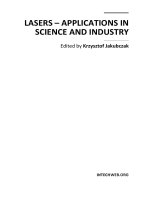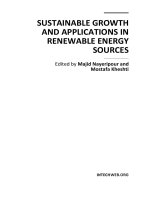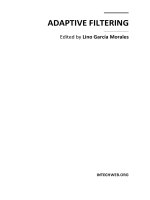Energy Management Systems 2012 Part 1 ppt
Bạn đang xem bản rút gọn của tài liệu. Xem và tải ngay bản đầy đủ của tài liệu tại đây (439.06 KB, 20 trang )
ENERGY MANAGEMENT
SYSTEMS
Edited by P. Giridhar Kini
and Ramesh C. Bansal
Energy Management Systems
Edited by P. Giridhar Kini and Ramesh C. Bansal
Published by InTech
Janeza Trdine 9, 51000 Rijeka, Croatia
Copyright © 2011 InTech
All chapters are Open Access articles distributed under the Creative Commons
Non Commercial Share Alike Attribution 3.0 license, which permits to copy,
distribute, transmit, and adapt the work in any medium, so long as the original
work is properly cited. After this work has been published by InTech, authors
have the right to republish it, in whole or part, in any publication of which they
are the author, and to make other personal use of the work. Any republication,
referencing or personal use of the work must explicitly identify the original source.
Statements and opinions expressed in the chapters are these of the individual contributors
and not necessarily those of the editors or publisher. No responsibility is accepted
for the accuracy of information contained in the published articles. The publisher
assumes no responsibility for any damage or injury to persons or property arising out
of the use of any materials, instructions, methods or ideas contained in the book.
Publishing Process Manager Iva Simcic
Technical Editor Teodora Smiljanic
Cover Designer Jan Hyrat
Image Copyright 2010. Used under license from Shutterstock.com
First published July, 2011
Printed in Croatia
A free online edition of this book is available at www.intechopen.com
Additional hard copies can be obtained from
Energy Management Systems, Edited by P. Giridhar Kini and Ramesh C. Bansal
p. cm.
ISBN 978-953-307-579-2
free online editions of InTech
Books and Journals can be found at
www.intechopen.com
Contents
Preface IX
Part 1 Energy Efficiency, Optimization,
Forecasting, Modeling and Analysis 1
Chapter 1 Energy Efficiency in Industrial Utilities 3
P. Giridhar Kini and Ramesh C. Bansal
Chapter 2 Methodology Development for a
Comprehensive and Cost-Effective Energy
Management in Industrial Plants 15
Capobianchi Simona, Andreassi Luca, Introna Vito,
Martini Fabrizio and Ubertini Stefano
Chapter 3 Energy Optimization:
a Strategic Key Factor for Firms 55
Stefano De Falco
Chapter 4 Use of Online Energy System
Optimization Models 85
Diego Ruiz and Carlos Ruiz
Chapter 5 Energy Demand Analysis and Forecast 101
Wolfgang Schellong
Part 2 Energy Systems: Applications, Smart Grid Management 121
Chapter 6 Energy Management for Intelligent Buildings 123
Abiodun Iwayemi, Wanggen Wan and Chi Zhou
Chapter 7 Orientation and Tilt Dependence of a Fixed PV Array
Energy Yield Based on Measurements of Solar Energy
and Ground Albedo – a Case Study of Slovenia 145
Jože Rakovec, Klemen Zakšek, Kristijan Brecl,
Damijana Kastelec and Marko Topič
VI Contents
Chapter 8 Optimal Design of Cooling Water Systems 161
Eusiel Rubio-Castro, José María Ponce-Ortega
and Medardo Serna-González
Chapter 9 A New Supercapacitor Design Methodology
for Light Transportation Systems Saving 183
Diego Iannuzzi and Davide Lauria
Chapter 10 Management of Locomotive
Tractive Energy Resources 199
Lionginas Liudvinavičius and Leonas Povilas Lingaitis
Chapter 11 An Adaptive Energy Management System Using
Heterogeneous Sensor/Actuator Networks 223
Hiroshi Mineno, Keiichi Abe and Tadanori Mizuno
Chapter 12 Smart Grid and Dynamic Power Management 239
Dave Hardin
Chapter 13 Demand Management and Wireless
Sensor Networks in the Smart Grid 253
Melike Erol-Kantarci and Hussein T. Mouftah
Preface
Energy management has become an important issue in recent times when many
utilities around the world find it very difficult to meet energy demands which have
led to load shedding and power quality problems. An efficient energy management in
residential, commercial and industrial sector can reduce the energy requirements and
thus lead to savings in the cost of energy consumed which also has positive impact on
environment. Energy management is not only important in distribution system but it
has great significance is generation system as well. Smart grid management and
renewable energy integration are becoming important aspects of efficient energy
management.
The management of energy technology and its applications in residential, commercial
and industrial sector is a diversified topic and quite difficult task to document in a
single book. This book tries to cover many important aspects of energy management,
forecasting, optimization methods and their applications in selected industrial,
residential, and generation system. This book comprises of 13 chapters which are
arranged in two sections. Section one covers energy efficiency, optimization,
forecasting, modelling and analysis and section two covers some of the diversified
applications of energy management systems for buildings, renewable energy
(photovoltaic system), design of cooling water systems, super capacitor for
transportation systems, locomotive energy systems and smart grid management. Brief
discussion of each chapter is as follows.
Chapter 1 looks into the energy audit and management requirements, alternate
sources of energy, power quality issues, instrumentation requirements, financial
analysis, energy policy framework and energy management information systems
(EMIS) for an industrial utility.
Chapter 2 presents a detailed methodology for the development of energy
management in industrial plants. The main aspects of energy management
methodology are: energy cost and consumption data and their analysis, forecasting,
sub-metering, tariff analysis, consumption control, budgeting and machines
management optimization.
X Preface
Chapter 3 presents an innovative methodology for the productive process
quantification optimization in aluminum bar industry. Energy optimization has a high
impact on service industry which has been discussed for a water supply company.
Chapter 4 discusses the online energy system optimization and demonstrates energy
optimization application in thermal power generation sector. A detailed model of
energy systems comprising of fuel system, boiler feed water, steam, electricity
generation, and condensate network is built within energy management system (EMS)
environment and it is continuously fed with real time data. Optimization is configured
to minimize the total cost. Besides real time optimization, key performance indicators
(KPIs) targets can also be set up. The chapter also discusses many examples in open
and closed loop implementation in power generation sector.
Chapter 5 presents energy demand analysis and forecasting. The modeling results are
interpreted by statistical tests and the focus of the investigation lies in the application
of regression methods and neural networks for the forecast of the power and heat
demand for cogeneration systems. The application of the proposed method is
demonstrated by the heat and power demand forecast for a real district heating system
containing different cogeneration units.
Chapter 6 discusses about intelligent buildings their automation and home automation
networks. This chapter surveys appliance and lighting load energy management
strategies that works to achieve the three goals of building energy management, i.e.,
reduction of energy consumption of building; reduction of electricity bills while
increasing comfort and productivity to occupants; and the improvement of
environmental stewardship. Smart grid security and security threats that need to be
addressed are also discussed in the chapter.
Chapter 7 reviews the parameters that affect PV systems’ efficiency and diffuse of
solar irradiance. The results of energy yield and gains by the optimal fixed azimuth
and tilt angle are presented. The important results of the chapter are the contour plots
with appropriate combination of tilt and azimuth angles for four typical locations in
Slovenia.
Chapter 8 presents an optimization model and detailed design of cooling water
systems. The cooling water structure embeds all possible combinations of series-
parallel arrangements of heat exchanger units. The model is based on a mixed-integer
nonlinear programming to determine the cooling water system design which
minimizes the total annual cost. Two examples are demonstrated to show the savings
which can be obtained with the proposed design.
Chapter 9 discusses the fundamental characteristics of super capacitor devices. Some
preliminary consideration with respect to optimization methodologies are presented
and light transportation systems modeling for both stationary storage systems and on-
Preface XI
board are discussed. A numerical application is reported for a case study with two
trains along double track dc electrified subway networks both for stationary and on-
board applications.
Chapter 10 presents different types of locomotive energy saving systems which are
used in aeroefficient optimized trains, energy management control, energy storage
systems. New technologies of traction motors of increased energy efficiency at reduced
volume and weight are discussed. The theoretical and practical possibilities of dc/dc,
ac/dc, ac/ac traction system locomotive regenerative braking energy management are
suggested. Catenary free system for trams, light rail vehicles, trolleybuses are
presented. Energy saving and power supply optimization possibilities using
regenerative braking energy are also discussed in the chapter.
Chapter 11 has developed an adaptive energy management system (A-EMS) for
controlling energy consumption by converging heterogeneous networks such as
power line communications (PLC), Wi-Fi networks, ZigBee, and future sensor
networks. In this work a prototype system enables users to freely configure a
cooperative network of sensors and home appliances from a mobile device.
Experimental results demonstrate that the proposed system can easily detect waste
electrical energy.
Chapter 12 discusses the eight priories of US smart grid, i.e., wide area awareness,
demand response and consumer energy efficiency, energy storage, electric
transportation, cyber security, network communications, advance metering
infrastructure, and distribution grid management. This chapter discusses the
importance of customer feedback loop in smart grid. Finally chapter discusses about
customer load response, commercial and industrial dynamic power management
strategies, distributed generation and industrial micro grids.
Chapter 13 presents discussion on demand management and use of wire sensor
networks (WSN) in generation, transmission and distribution and in demand side
management. Various types of demand management system, i.e., communication
based, incentive based, real time and optimization based have also been discussed in
the chapter.
Editors are grateful to a number of individuals who have directly or indirectly
contributed to this book. In particular Editors would like to thank all authors for their
contributions. Editors are indebted to all the reviewers for reviewing the book chapters
which has improved the quality of book.
Editors would like to thank the authorities and staff members of Manipal University
and The University of Queensland who have been very generous and helpful in
maintaining a cordial atmosphere and extending all the facilities required for the book.
Thanks are due to InTech - Open Access Publisher, especially to Ms. Viktorija Zgela
and Ms. Iva Simcic, Publishing Process Manager for making sincere efforts in timely
XII Preface
bringing out the book. Editors would like to express thanks and sincere regards to
their family members who have provided great support for completion of this book.
P. Giridhar Kini
Dept of Electrical & Electronics Engg,
Manipal Institute of Technology, Manipal,
India
Ramesh C. Bansal
School of Information Technology & Electrical Engineering,
The University of Queensland,
Australia
Part 1
Energy Efficiency, Optimization,
Forecasting, Modeling and Analysis
1
Energy Efficiency in Industrial Utilities
P. Giridhar Kini
1
and Ramesh C. Bansal
2
1
Dept of Electrical & Electronics Engg, Manipal Institute of Technology, Manipal
2
School of Information Technology & Electrical Engineering, The University of Queensland
1
India
2
Australia
1. Introduction
The demand for electrical energy has increased tremendously over the last 25 years; its
importance is such that it is now a vital component of any nation’s economic progress.
Increase in population has increased the energy requirements, coupled with the
industrialization & socio-economic responsibilities; the energy supply has not kept pace with
the demand. This has led to a bleak energy scenario whereby power generation and utilization
from alternate energy sources has become very much a necessity. In the industrial context,
electrical energy is used to produce a desired output, given the availability of all the relevant
raw materials. For a nation to progress economically, the industrial sector has to be constantly
encouraged and developed, but as the number of industrial units / sectors increase, energy
demand and consumption also increases. The industrial sector is the largest consumer of all
the electrical energy that is commercially generated for utilization, and process industries like
fertilizer, cement, sugar, textile, aluminum, paper, etc.; are extremely energy intensive in
nature. To reduce the increasing demand-supply gap, either more industrial energy has to be
generated or the existing consumption of energy has to be brought down without any
compromise on either product quality or quantity. The rate of growth in the domestic sector
easily outnumbers the industrial sector. In the event of power shortage, industrial sector gains
precedence over other sectors, thereby, domestic sector always bears the brunt of long or
constant power cuts. The impact of rising energy cost has a disastrous impact on the day-to-
day activities of industrial and domestic consumers wherein the prices of commodities,
products and even essential services tend to cost more. One option is to improve the working
efficiency of the process and systems. This will ensure the reduction in the product cost in
addition to efficient energy management. The other option is the use of energy derived from
non-conventional energy sources i.e.; ensure a balance between conventional and non-
conventional energy sources in the process. With depleting coal reserves, it is very essential to
develop the renewable energy technology so as to be an alternative option. Amongst the
various renewable energy sources, solar energy is the best possible option and finds
application in most of the domestic and industrial processes.
2. Energy audit
With the conventional fuel supplies becoming scarce and more expensive, and the initial
investment for harnessing energy from renewable sources being too high; the concept of
Energy Management Systems
4
energy auditing and energy conservation / efficiency practices have gained significant
importance especially in energy intensive industries. Energy audit programmes are
inexpensive investments, as compared to the cost of energy utilization, and are an important
tool in analyzing and controlling the demand-supply situation. An energy audit serves to
identify and quantify all forms of energy usage. The main aim of energy audit is to maintain a
proper balance between energy required and the energy actually utilized; while the main
objectives of energy audit are to (i) analyze the energy consumed and wasted (ii) develop ways
and means to utilize the available energy in the most efficient manner by the use of energy
efficient devices (iii) adopt suitable operational strategies, and (iv) time scheduling (e) demand
limiting. An industrial energy audit is the most effective tool in bringing out as well as
pursuing an effective energy conservation programme. In the industrial context, energy
auditing is the process of identifying energy dependent equipment in the system / sub-system
processes, quantifying the amount of energy consumed by each of the individual equipment
and then, analyzing the data obtained to identify energy conservation opportunities. As
processes vary from plant to plant and from sector-to-sector, so do the use and type of
equipment; the nature and type of energy audit also varies. Thus there cannot be a standard
way of doing an energy audit, but it typically involves analyzing past and present energy
consumption data, comparison of actual consumption to the standard consumption data,
comparison of present consumption with other firms in the same industrial sector, checking
working capacities and overall efficiencies of equipment, review of fuel storage and handling,
development of energy use indices for performance comparison, analysis of energy saving
incentives and reviewing the need for new energy saving techniques.
All processes and hence energy audit for the process can be divided into three general
stages: input side, process side and the output side [1]. The input side energy audit involves
an analysis of the fuels used in terms of quantity and quality. The process energy audit
involves the analysis of the process in addition to the energy consuming equipment at
various stages / sub-stages individually. The output side energy audit deals with the energy
that is either rejected or lost out to the surrounding environment. As a number of stages and
sub-stages are involved in every process, starting from the input to the final product, the
type of the energy audit now becomes very important.
The type of energy audit can be classified into a walk-through audit and a comprehensive
audit. A walk-through audit takes the least possible time and generally involves moving
around the facility looking for simple possible steps to minimize energy wastage or
improving the system process leading to better energy utilisation ie; walk-through audit
covers only a general notation of the performance. A comprehensive audit involves a longer
time frame and generally involves getting into the indepth details of process, i.e.;
comprehensive audit covers specific information [2]. A well designed and properly executed
extensive energy audit programme will reveal the various areas of energy wastage and
process inefficiencies, thereby pin-pointing the areas of immediate improvement.
The energy audit whether walk-through or comprehensive should be carried out by an
energy auditor specifically designated for the purpose. The energy auditor may be from
within the organization or an expert / consultant not connected with the organization, but
must be well versed with the process involved. The main responsibilities of the energy
auditor are:
Plan, direct and execute an extensive energy audit process wise and system wise
Quantify the process and system energy needs
Quantify the process and system efficiencies
Energy Efficiency in Industrial Utilities
5
Compare the present data with historical data
Identify the various energy saving measures, analyze their technical / financial
feasibility
Organize the energy saving measures into low / medium / high priority and also into
proposals requiring small / large investments
Documentation regarding the energy saving proposals
Appraise / convince the management regarding the need for implementation of energy
saving measures
Follow up on the implementation with periodic monitoring / appraisal
Investment related energy saving proposals require the consent of the management. In such
cases, the decision making does not rest with energy auditor. It therefore becomes important
that the energy auditor must prepare a detailed report listing out the various options
available, their technical feasibility, financial requirements, time frame needed and possible
gains that can be achieved. Thus the role of the energy auditor becomes very important. An
energy audit report for a work area within the plant facility should essentially cover the
following and the same can be extended to other units with relevant changes so as to form
an energy audit report for the plant.
Company details: name, location, power, fuel & water demand, products manufactured
Work area details: name, dimensions, working hours, power, fuel, water & process
requirements, process description, work output
Device details: devices used, nameplate details, accessories, metering, control
parameters, age, assumptions, maintenance details
Observations: input, process & output, loading pattern, inefficiencies, wastages,
comparison with historical data, possible reasons for deviations, potential opportunities
Operational difficulties: feedback from personnel, maintenance, housekeeping,
maintenance records
Recommendations: input, process & output changes, replacements, retrofits,
investments, training
Benefits: process & product improvements, power, material & monetary savings,
economic analysis, payback periods, forecasting
Options available: tariff, efficient devices, systems, vendors, rebates, subsidies
Probable implementation plan: time period, priorities, training requirements,
investments
References list: technical reports, handbooks, manuals
Team details: plant work area, energy audit
The energy audit report must be simple in presentation as it should be understood by all
concerned be it the president of the company or the maintenance personnel. It is also essential
that the report be written in a manner that even a non-technical person should be in a position
to understand the underlying message. The report should be a blend of text, figures, tables, etc.
so that it is not monotonous in nature. The assumptions made during the energy audit must be
easily justifiable. All standard formulas and measuring units can be a part of the annexure for
reference. There must be consistency in information flow, i.e.; same variables or notations must
be not be used a second time that may lead to confusion. The energy audit report can be in two
parts: first part being the overall summary that highlights the important details and second
part being the indepth report. This will enable the top management to concentrate only on the
first part and in case of need of discussions, second part will be handy. In addition, the report
Energy Management Systems
6
should be sensible from the technical & financial point of view, i.e.; it should be encouraging
enough for the management to realize that implementation will lead to better prospects. Thus
a reader friendly energy audit report is an important step in initiating the implementation of
audit recommendations.
Successful completion of an energy audit identifies the areas for improvement, which leads
to listing out a number of energy conservation proposals. Indepth discussion with the
relevant people leads to an energy management strategy which is quite significant in
bridging the gap between availability and requirement of electrical power.
3. Energy management
Energy management embodies engineering, design, applications, utilization, and to some
extent the operation and maintenance of electric power systems to provide the optimal use of
electrical energy [2]. The most important step in the energy management process is the
identification and analysis of energy conservation opportunities, thus making it a technical
and management function, the focus being to monitor, record, analyze, critically examine, alter
and control energy flows through systems so that energy is utilized with maximum efficiency
[1]. Every industrial facility in a particular location is unique in itself; hence a systematic
approach is extremely necessary for reducing the power consumption, without adversely
affecting the productivity, quality of work and working conditions. Thus, for any process,
energy conservation methodologies can be categorized into (i) housekeeping measures (ii)
equipment and process modifications (iii) better equipment utilization and (iv) reduction of
losses in building shell [3]. Thus energy management involves consumption and optimization
of energy usage at various stages in the plant process in the most efficient way.
Energy management is responsibility of all involved in the industrial process but there must
be person(s) specifically designated to oversee the implementation of energy efficiency
proposals. Thus the role of energy manager is equally important as that of the energy
auditor. The energy manager should have upto date technical skills to understand intricate
technicalities of the process and excellent managerial skills in order to plan, organize, direct
and control the various energy requirements. This will ensure that competency of the energy
manager will not be questioned at any point in time and also, the top management can rest
assured that targets set will be easily achieved. The main responsibilities of the energy
manager are:
Setting up of an energy management cell with well-defined objectives
Generate ideas for energy management to create / promote awareness
Initiate regular training programmes for constant knowledge updation
Initiate steps for appropriate monitoring and recording practices
Set targets that are realistically achievable by all concerned in the process
Proper implementation of the energy audit findings
Ensure that all data related to unit / plant are maintained centrally and easily accessible
Ensure coordination between top, middle and lower management personnel
Associate with energy managers of related industries for information exchange
Ensure easy information flow through proper communication
An energy manager’s report for a work area within the plant facility should concentrate on
the findings of the energy audit report, take into account the historical data and set realistic
benchmarks / targets that contribute significantly towards energy efficiency. The reports









